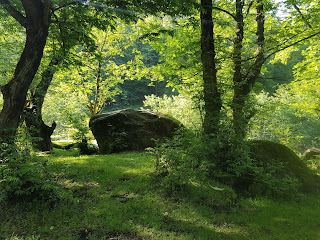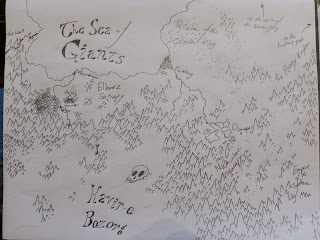The second half of the letter G, fittin' it in before the end of the month!
Goldbug
★★★★☆
I'll admit, I had never read the goldbug entry before! Probably mostly because it doesn't have an illustration. Not exactly the most complex monster, just a nice lil bug that looks like a gold coin and can bite you. Save or die poison isn't the best but it's to be expected really. I put the Dungeon Meshi coin bug picture here because that is just such a good rendition of this concept. Dungeon Meshi also has a whole lot of variety of treasure insects which is super great!
Gorbel
★★★☆☆
I do very much like the look of this weird little critter, but it isn't all that interesting in implementation. Its basically just a single surprise gimmick; it has a high armor class in normal combat, but can only attack someone by attaching onto them with its claws which lowers its AC to the worst possible... but then if you hit it with any kind of sharp weapon it will burst open and deal damage to the person it is clinging to and whoever attacked it and anyone within 5 feet. I will say at least it has a lot of good personality: the illustration makes it look like the gorbel really doesn't like doing what it does, though that is kinda contradicted by the mention that they are "mischievous, fickle and irritable creatures" at the end of the description. I think the surprise gimmick thing would be interesting if it was paired with more of a personality, like perhaps if you could talk to it etc etc but the gorbel as presented isn't really that. It gets an extra star for the illustration though, otherwise it'd be a 2 star beastie.
Gorilla Bear
★☆☆☆☆
The epitome of "just use bears". Stats-wise and in terms of how one would use it, the gorilla bear is literally just a normal bear. The description doesn't even say they have any kind of special Thing from being part gorilla other than the literal parts that they have, they just reference "the aggressive disposition of the grizzly bear and the carnivorous tendencies of the cave bear". Yknow last I checked grizzly bears were carnivorous too. They just have the hug attack from the owlbear too. Also, the end of the description says they won't have the bear ability to keep fighting past 0 hit points... do bears have that in AD&D??? I wasn't aware of that at all, that's kinda interesting actually, though not interesting to necessitate making this better since its something the gorilla bear doesn't have. I will say though, the image of some kind of horrible taxidermy beast with a gorilla's head on a bear body is kinda cool, just that isn't what this creature is. Very boring!
Grell
★★★★☆
The grell would be five stars if it didn't make you roll an ungodly amount of dice. Conceptually/visually, just a masterpiece, there's a reason why the grell became such a D&D mainstay since it was published in the Fiend Folio. A floating brain with lots of tentacles and a horrid little parrot beak is just such a good design. However, mechanically? Mechanically this thing is hell. It has ten separate tentacle attacks each round, which are explicitly always targeted at the same victim, and each successful tentacle attack prompts a saving throw (with a bonus for uh some reason?) to avoid being paralyzed. If someone is paralyzed, the grell latches onto them with two tentacles while they continue to attack that one person with the other eight and a beak attack. Before that paralyzation, you have to make ten attack rolls directed all at the same victim and said victim has to make up to ten distinct saving throws, and once the paralyzation has taken effect they just automatically deal damage! It is just so so much rolling for an effect that in the end is just paralyzation and a huge amount of damage. At the very least it is cool that there is a built-in way to weaken the effectiveness of it, by hacking off its tentacles, I just think it didn't need that much dice rolling. Call me some kind of crazy person, but personally I would rather a simplified handling of this than having to make ten to twenty rolls for one monster each round of combat. Love the design though forreal.
The grell first featured in the Fiend Factory column, in a form nearly identical with that reproduced in the Folio. Much of the phrasing is exactly the same even. As a result, I don't really have anything interesting to say about it. I will, however, reproduce in its entirety Don Turnbull's commentary: "This thing is even worse than the Carrion Crawler - with ten tentacles hitting, there's not much chance of avoiding paralyzation; lucky it only attacks on the '5 dice' line. I should have thought the sight of this beast would be likely to induce fear in low-level characters as the Mummy. It's not often we have such a powerful entrant in the Factory, but this one is mighty interesting... in its way (I would not like to meet it)."
 |
| A bunch of good boys just hanging out :) |
Grimlock
★★★★☆
I'm so happy that the Fiend Folio officially introduced morlock ripoffs into D&D. The morlocks from H.G. Wells's The Time Machine are just such a good iconic creature, and they are handled pretty well here! I also feel like degenerate underground morlock types are a common sword and sorcery/science fantasy enemy you see in OSR circles, and for good reason! Plus, as a race of humanoids, they're very good for faction play, and being able to communicate with them and engage with their leadership structures is very good. Personally I would make them weirder but eh, take what you can get. I like that they are blind, and I like that the description is explicit as to what the mechanical effects of said blindness are, but I kinda wish they were just completely eyeless instead of having white milky eyes, eyelessness is such a good feature to give subterranean humanoids. The mentions of other creatures that live in their lairs with them is phenomenal, and that alone provides the grimlocks with so much more flavor than a lot of other humanoids. Why medusas live with them seems pretty self explanatory (since they can't see they can't get petrified), but mind flayers also live with them, which is just wild! I like how it mentions that the githyanki hate them because they consort with mind flayers, thats really good. Them being able to blend in with stone so long as they remain motionless is great, I can already imagine the weirdness from an encounter with them. Grimlocks are great, I do just wish they were more science fantasy-y than being just another Gygaxian humanoid race, but that doesn't make me dislike them!
Gryph
★★★★☆
Another sleeper hit! I don't think I've ever given the gryph the time of day, since it is sandwiched right after the grimlocks, but oh my god this is such a good concept. Let me summarize it for you: many-legged parasitoid birds. I already love parasitoid things both real and fictional, I already love many-legged birds (just go back to the first review to see me lavish praise on the Assassin Bug and Achaierai), this combines them in a super weird way. Why on earth are the female gryph's eggs implanted "through a thin tube which projects from the bird's abdomen"??? I know the abdomen is the posterior portion of an insect, but on a vertebrate wouldn't that make it protrude from the area of the stomach? I will say, however, that I wish they didn't obfuscate the absolutely incredible weirdness of this creature behind random rolls. Only female gryphs do the parasitoid egg thing, and you only ever run into a female if you roll 3 or more on the number encountered, so thats a 2-in-6 chance that you don't even have a chance of having to deal with the eggy weirdness, and then even if a female is present there is only a 35% chance that it will lay its eggs. This means that in a given gryph encounter, there is only a 23.33% chance of even having to contend with the egg laying. Who on earth is going to make gryphs a significant enough part of their game that they'd have to make sure only a quarter of the time it does its one special thing? These are really fun and unique and weird creatures, show off their weirdness!! Docking one star for the wonky probability here, but I love the concept, making a bird parasitoid is so fun.
Guardian Daemon
★☆☆☆☆
I wanna know how they made "demon bound by an evil high priest to guard a specific spot" into something so boring. The guardian daemon is just so generic. It doesn't even get its own unique appearance, they basically just say that it can look like anything, even other demons... wow! If it can look like another demon, I would just rather have it so that the evil high priest can just bind that demon! This just obfuscates things and makes them much less interesting. Its powers are boring: a normal bite attack, two normal claw attacks, it can breathe fire... what about this is daemonic? I at least like that while it has immunity to non-magical attacks, it always has one type of non-magical attack it isnt immune to. That has a kinda fun folkloric vibe to it, but again handled so generically. Its art shows it emerging out of an egg, that makes me wish this were a creature that could be summoned by breaking open an egg, that'd be much more interesting.
Guardian Familiar
★★★☆☆
Now I know what you're thinking. I just gave the guardian daemon a worse score, why does basically the same monster but now it's a cat get three stars? Well you see: it is a cat. Just by being an actual specific thing it is already by default better than the guardian daemon. On top of that, the guardian familiar has the absolutely incredible power of having nine lives. I love that so much!! Each time it is killed, it is instantly reborn, but now stronger. It also grows in size as it attacks, larger and larger from its initial small black cat appearance. It also stays put on top of the treasure it is supposed to guard, instead of the guardian daemon's generic ability to move around but only within a certain area. The guardian familiar just feels much more folkloric, it really feels like the kind of supernatural critter that a witch would have! Solely by having more interesting and unique powers, it is leagues better than the guardian daemon. Its honestly kinda funny that they're on the same page; the guardian familiar instantly shows you a better way to do the guardian shtick than the guardian daemon. Also the art is cute.

























